How far will your money go during residency?
For recently matched medical students on the precipice of the next phase of their training, that question might be top of mind.
It’s a question that Humam Shahare—a fourth-year medical student in Arkansas—and a group of his peers attempted to shed some light on in a research poster.
The poster examined PGY-1 salaries from integrated plastic surgery residency programs across the U.S and compared them with cost-of-living data. The research’s findings—which can be broadly applied across residency training specialties and institutions—were that rather than having the highest salary, geography played a bigger factor in surplus income.
The AMA Road to Residency series provides medical students, international medical graduates and others with guidance on preparing for residency application, acing your residency interview, putting together your rank-order list and more.
Doing the math
While starting salary may be an factor residency applicants consider in where they want to train, it is a flawed metric.
Shahare’s poster, which was created in 2023, found that first-year integrated plastic surgery residents had an average starting salary around $65,000. The average surplus income, defined as PGY-1 salary minus cost of living, for those residents was more than $23,000. Residents who trained in areas with lower costs of living had lower salaries, but they also had a higher surplus income.
“It’s not how much you make, it’s how much do you have at the end of the day,” said Shahare, an AMA member. “That’s what is going to answer, ‘Are your bills taken care of?’.”
The study also offered insights on where residents can get the most bang for their buck. Residents training in the Midwest—according to regions defined by the U.S. Census Bureau—had the highest average surplus income at more than $27,00. Residents training in the West had the lowest average surplus income at around $20,000.
Dive deeper:
- How to make the most of your post-Match time in med school
- You made it—will your wallet? How to budget in physician residency
- Trouble financing your move for GME? Consider this option
- These 8 traits make great doctors, and residents can develop them
- Resident physician in the big city? You may need a roommate—or four
Cost of living and training preferences
In an interview, Shahare said he plans to make cost of living a factor in deciding where to train. He also understands that it’s not going to impact everyone’s plans.
“Medicine is a competitive career path, and understanding that, some people are OK having to stretch and tough it out for a few years in New York to train to be a neurosurgeon,” Shahare said. “At the same time, that person could live that life in Arkansas and have something like 300% more income. It’s different weather and different scenery.”
For example, living in San Franciso, one of the most expensive urban areas in the country as a resident, Christina Wang, MD, has had to be strategic about her living expenses. Dr. Wang, formerly an internal medicine resident, had three roommates and 1.5 bathrooms in a four-bedroom apartment.
Even with less surplus income, Dr. Wang said “there are still ways to make it work in a high-cost-of-living city. I was fine with having roommates and a smaller space, recognizing that it was a lot more important for me to be near family and loved ones rather than in a new city with a much more affordable cost of living.”
To stretch her money, Dr. Wang found that sticking to a budget was key.
“You really have to work on your budgeting skills,” she said. “People tell you how much you should be saving, and you still want to do things for yourself like go on vacation. You just have a much smaller piece to work with for those things.
One workable option is the 50–30–20 rule, which divides a paycheck into three categories. The bulk (50%) goes to essentials such as rent, groceries and utilities. Another 30% goes to more flexible—and less essential—spending. And 20% goes to savings and debt payments. Laurel Road—a preferred provider of the AMA for student-loan refinancing—offers a budget calculator to help residents track their income.
For graduating medical students looking to hit the ground running in the next phase of their training, the AMA Thriving in Residency series offers timely guidance on making the most of your residency training. Get tips about navigating the demands of training, getting scientific research published, maintaining health and well-being, and handling medical student-loan debt.



